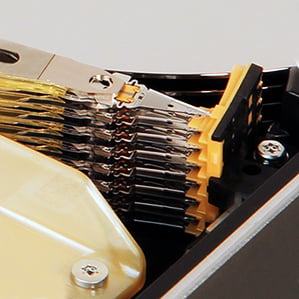Fast and Spacious Helium-Filled Hard Drives Ready for Liftoff
Data-storage company HGST has begun making a six-terabyte hard drive that has a 50 percent greater storage capacity and uses about 20 percent less power than conventional hard drives. The secret to this leap forward in performance? Pumping the drives full of helium.

Helium reduces friction, vibration, and other mechanical issues that limit the storage density of conventional hard drives. It also makes hard drives less power hungry.
The hard-drive industry has been eyeing helium since the 1970s, but no company has ever been able to make it work because helium has a tendency to leak out of whatever container it’s placed inside—the same phenomenon that causes birthday balloons to droop a few days after a celebration. The result for a helium-filled hard drive is more serious: it’ll stop working.
HGST, headquartered in San Jose, California, says it has overcome these challenges and is producing hard drives guaranteed to last five years. The company is slowly ramping up production of the hard drives for its first customers, including Chinese telecommunications company Huawei, European physics institute CERN, and computer maker Hewlett-Packard.
Helium-filled hard drives could be appealing to data centers and businesses like banks and insurance companies that handle vast amounts of information. The new drives should boost storage capacity while keeping power consumption in check, says Fang Zhang, an analyst at IHS Global Insight.
In 2013, hard-drive makers will ship devices with a total capacity of about 750 billion gigabytes. Zhang projects that by 2020 there will be a demand for 3,500 billion gigabytes of data storage, 60 percent of which will be stored in the cloud in data centers, compared with 20 percent today.
Stacked inside a hard drive are magnetically patterned platters, each of which has an arm suspended over its surface. A read-write head hovers over the platter very close but without touching—about a nanometer away—using a magnetic field to read and write information. These tiny size scales and the high speeds of rotation (hard-drive disks spin at about 7,200 rpm) make hard-drive design very tricky.
As the platters in a hard drive start to move, the air surrounding the disk’s surface also begins to rotate. A hard-drive disk spinning in air meets resistance and tends to flutter, putting strain on the motor, requiring more power. Since helium flows better than air, drives filled with the gas experience very little friction, and the arms suffer less turbulence.
“If the arm vibrates with even a nanometer amplitude, you’re toast,” says Hossein Haj-Hariri, a professor of mechanical engineering at the University of Virginia in Charlottesville, who has modeled the fluid dynamics of air and helium in hard drives. “Helium spills over and behind the arm, and the turbulence in helium decays rapidly,” he says.
Lower levels of vibration and friction mean lower power consumption, lower operating temperatures, and greater storage density because a steadier arm is able to dip down to a particular spot on the steady platter with finer spatial registration. With fewer tendencies to flutter, the disks can also be made thinner, so more fit in the same case. The new drives contain two extra platters, for a total of seven.
Smoother mechanics also result in operating temperatures that are 4 °C lower than conventional hard drives. HGST says the drives can lead to a 49 percent reduction in watts consumed per terabyte stored for a data center.
The numbers are not surprising to analysts and researchers who have been working on helium technology over the past four decades. “People have constantly talked about the advantages of helium but haven’t been able to make it work because it escapes the enclosure over time,” says Frank Talke, a professor at the University of California, San Diego, Center for Magnetic Recording Research, who worked on an early helium-hard-drive project at IBM in the 1970s.
HGST has not released any details about how it seals in the helium, beyond assurances that it is a hermetic seal guaranteed for five years, but Talke says it looks like the challenges have been overcome.
Zhang is cautious. “It depends on the real performance,” she says. “I think we’ll know in about a year.”
Keep Reading
Most Popular
Large language models can do jaw-dropping things. But nobody knows exactly why.
And that's a problem. Figuring it out is one of the biggest scientific puzzles of our time and a crucial step towards controlling more powerful future models.
How scientists traced a mysterious covid case back to six toilets
When wastewater surveillance turns into a hunt for a single infected individual, the ethics get tricky.
The problem with plug-in hybrids? Their drivers.
Plug-in hybrids are often sold as a transition to EVs, but new data from Europe shows we’re still underestimating the emissions they produce.
Google DeepMind’s new generative model makes Super Mario–like games from scratch
Genie learns how to control games by watching hours and hours of video. It could help train next-gen robots too.
Stay connected
Get the latest updates from
MIT Technology Review
Discover special offers, top stories, upcoming events, and more.